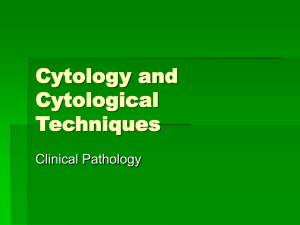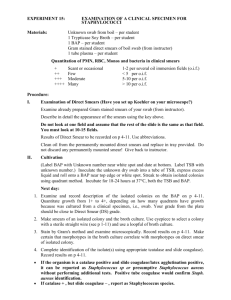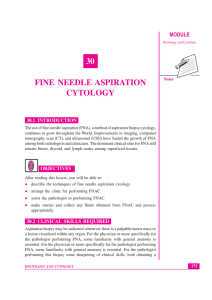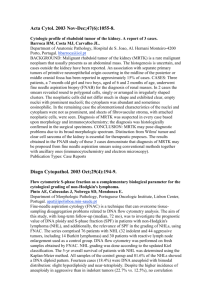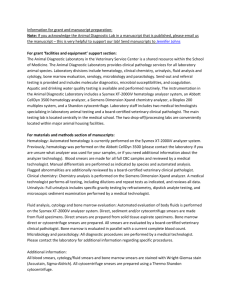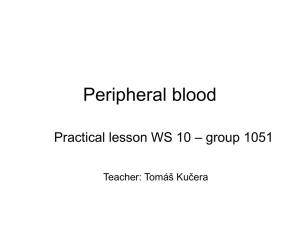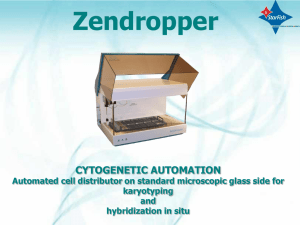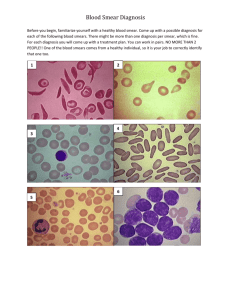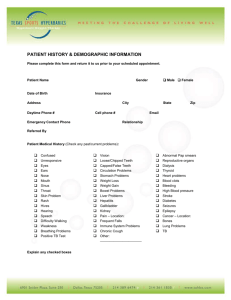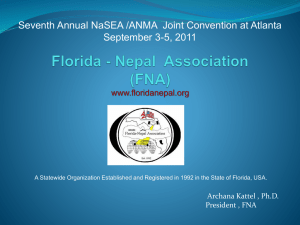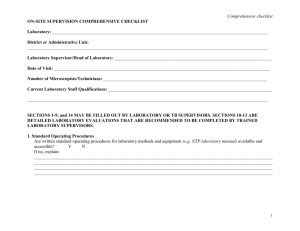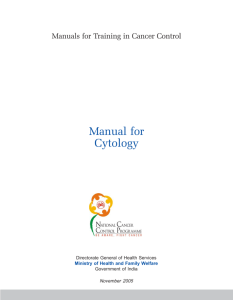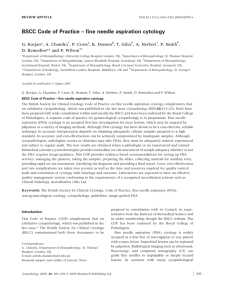interpretation of fna smears - journal of evidence based medicine
advertisement
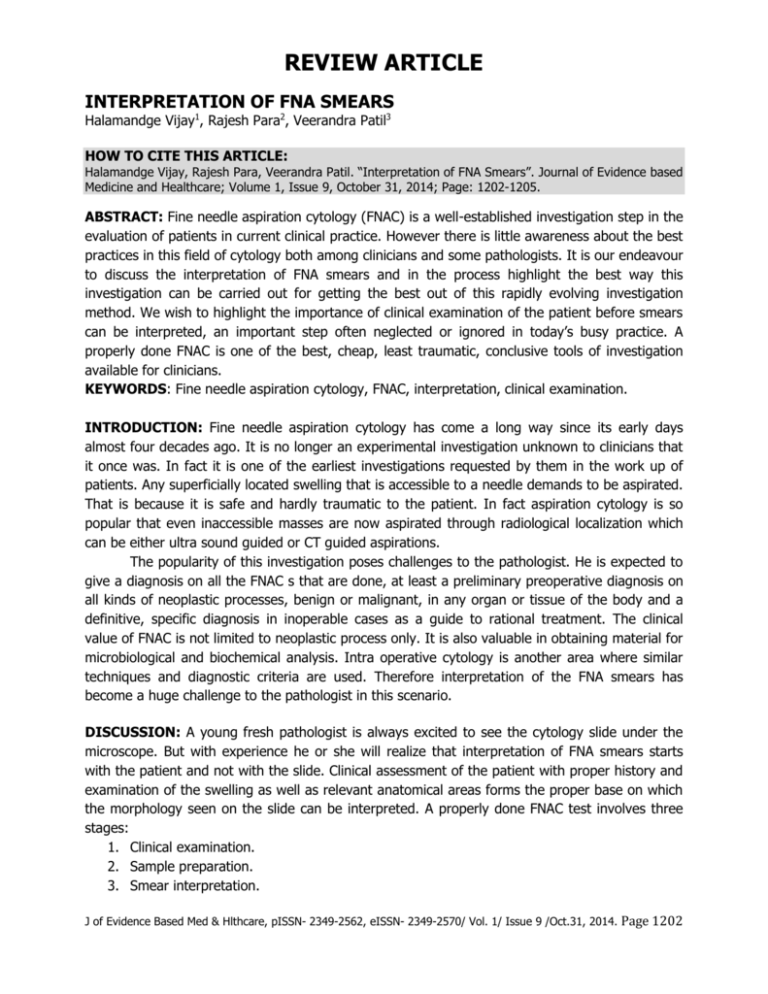
REVIEW ARTICLE INTERPRETATION OF FNA SMEARS Halamandge Vijay1, Rajesh Para2, Veerandra Patil3 HOW TO CITE THIS ARTICLE: Halamandge Vijay, Rajesh Para, Veerandra Patil. “Interpretation of FNA Smears”. Journal of Evidence based Medicine and Healthcare; Volume 1, Issue 9, October 31, 2014; Page: 1202-1205. ABSTRACT: Fine needle aspiration cytology (FNAC) is a well-established investigation step in the evaluation of patients in current clinical practice. However there is little awareness about the best practices in this field of cytology both among clinicians and some pathologists. It is our endeavour to discuss the interpretation of FNA smears and in the process highlight the best way this investigation can be carried out for getting the best out of this rapidly evolving investigation method. We wish to highlight the importance of clinical examination of the patient before smears can be interpreted, an important step often neglected or ignored in today’s busy practice. A properly done FNAC is one of the best, cheap, least traumatic, conclusive tools of investigation available for clinicians. KEYWORDS: Fine needle aspiration cytology, FNAC, interpretation, clinical examination. INTRODUCTION: Fine needle aspiration cytology has come a long way since its early days almost four decades ago. It is no longer an experimental investigation unknown to clinicians that it once was. In fact it is one of the earliest investigations requested by them in the work up of patients. Any superficially located swelling that is accessible to a needle demands to be aspirated. That is because it is safe and hardly traumatic to the patient. In fact aspiration cytology is so popular that even inaccessible masses are now aspirated through radiological localization which can be either ultra sound guided or CT guided aspirations. The popularity of this investigation poses challenges to the pathologist. He is expected to give a diagnosis on all the FNAC s that are done, at least a preliminary preoperative diagnosis on all kinds of neoplastic processes, benign or malignant, in any organ or tissue of the body and a definitive, specific diagnosis in inoperable cases as a guide to rational treatment. The clinical value of FNAC is not limited to neoplastic process only. It is also valuable in obtaining material for microbiological and biochemical analysis. Intra operative cytology is another area where similar techniques and diagnostic criteria are used. Therefore interpretation of the FNA smears has become a huge challenge to the pathologist in this scenario. DISCUSSION: A young fresh pathologist is always excited to see the cytology slide under the microscope. But with experience he or she will realize that interpretation of FNA smears starts with the patient and not with the slide. Clinical assessment of the patient with proper history and examination of the swelling as well as relevant anatomical areas forms the proper base on which the morphology seen on the slide can be interpreted. A properly done FNAC test involves three stages: 1. Clinical examination. 2. Sample preparation. 3. Smear interpretation. J of Evidence Based Med & Hlthcare, pISSN- 2349-2562, eISSN- 2349-2570/ Vol. 1/ Issue 9 /Oct.31, 2014. Page 1202 REVIEW ARTICLE All of these steps are interlinked and each one important for final analysis. However these points are not analyzed when doing studies on sensitivity and specificity of this test. In fact methodological issues underlying performance variation are poorly understood.1 Clinical examination is vital for final interpretation of FNA smears. There has been a recent trend by clinicians and general practitioners to perform FNA s in their clinics and send the slides for interpretation. No doubt every doctor may succeed in acquiring some material. But it is not always possible to interpret such slides. Besides the most valuable step of clinical examination of the patient by the person interpreting the slides is lost. In our experience it is best if the aspiration is performed by the pathologist experienced in the technique and who is going to finally interpret the smears.2,3 To quote a recent experience FNA done from a breast lump in a 22 year old young lady was sent for interpretation. On examination, the smears were cellular and showed cells with enlargement of nuclei. Because of doubt about the quality of fixation, young age of patient and lack of clinical information it was requested that patient be sent to our Centre for repeat aspiration. Upon repeat aspiration from a small freely mobile lump in the breast the smears were interpreted as fibroadenoma. This experience proves the importance of clinical examination as well as the proper technique for final interpretation of smears. Second step of technique of aspiration and smear preparation are also vital for final interpretation of smears. With proper guidance and experience one learns the best method of inserting the needle number of times and force to be used in moving the needle, the feeling of cutting of tissue by the needle, exact time to stop and express the material onto the slide the gentleness to be used in spreading the smear and naked eye examination of smears to judge presence of adequate material. Recent trend is for radiologists to do FNA under ultrasound or CT guidance. However the smear sent by them more often than not less than adequate for interpretation. Valuable cells are frequently enmeshed in clots. Spreading of smears shows artifacts and come in the way of interpreting the slides. In our experience it is best if the procedure is carried out by both where the radiologist places the needle in the right location and the pathologist does the procedure of aspirating and spreading and decides on the adequacy of material. Final step of interpretation of smears is almost half done if the previous two steps have been done correctly. The systematic approach to interpretation of smears involves assessment of cellularity, cell arrangement or distribution, cell type, cell morphology and background non cellular material. The overall cellularity of the smear has to be assessed keeping in mind that it varies depending on the technique and expertise of the person aspirating. However in general malignant lesions tend to yield high cellularity. But this is not always the rule. Sclerotic lesions and highly vascular lesions may show low cellularity. Cell type or the cell population on the smear gives important clues towards diagnosis. Monomorphic population of cells versus polymorphic population, benign versus malignant or both benign and malignant cells in same smear all these information are important for assessment. For J of Evidence Based Med & Hlthcare, pISSN- 2349-2562, eISSN- 2349-2570/ Vol. 1/ Issue 9 /Oct.31, 2014. Page 1203 REVIEW ARTICLE example, hepatocellular carcinoma often shows dysplastic liver cells along with frank malignant cells whereas metastatic carcinoma to liver shows admixture of benign hepatocytes and malignant epithelial cells. Presence of bipolar myoepithelial cells is an important clue towards benign nature of breast lesions. Cell arrangement is important but tricky for interpretation. The complex architecture seen in paraffin embedded tissue sections are not exactly reflected in smears. However cell architecture is still predictable according to the nature of the lesion. For example dissociated cells are seen in lymphomas, acinar and papillary arrangements are seen in adenocarcinomas, rosettes are seen in primitive neuroectodermal tumors and neuroblastomas so on. Cell morphology involves assessment of nuclear characters and cytoplasmic characters. Nuclear changes are vital for deciding benign versus malignant nature.4,5 Some characteristic nuclear characters like salt and pepper chromatin is typical of neuroendocrine tumors. Cytoplasm tends to be low in poorly differentiated carcinomas. Presence of cytoplasmic mucin helps in identifying mucinous adenocarcinomas. Similar examples are numerous and beyond the scope of this article. Finally the background non cellular materials give useful diagnostic information. Some of the background materials seen and the lesions that are typically associated by them are given in the box below. Background material and associated lesions Mucinous: - Mucinous adenocarcinoma Tigroid: - Seminoma, Dysgerminoma, Rhabdomyosarcoma Myxoid: - Myxoma, Chordoma, Pleomorphic adenoma Chondroid material: - Cartilagenous tumors Colloid: - Colloid goitre Lymphoglandular bodies: - lymphoid neoplasms Psammoma body: - Papillary carcinoma of thyroid, Meningioma, Adenocarcinoma of ovary Reinke’s crystals: - Sertoli cell tumors. CONCLUSION: Interpretation of FNA smears is complex and expertise is gained only with experience. It is important to remember that the clinical examination and technique of aspiration are equally important steps and should not be ignored in the final interpretation of smears. Despite all the recent publications in a host of cytology journals of rare conditions that have been diagnosed by FNA, it should be remembered that this procedure has its limitations and one J of Evidence Based Med & Hlthcare, pISSN- 2349-2562, eISSN- 2349-2570/ Vol. 1/ Issue 9 /Oct.31, 2014. Page 1204 REVIEW ARTICLE should not hesitate to give a descriptive diagnosis or a list of the differential diagnosis that has been considered rather than definitely committing to one single diagnosis and erring in the process. However when properly performed and interpreted by an expert in the field, it is still one of the easiest, cheapest and quick investigations that can aid the clinician in the management of patients. REFERENCES: 1. Schmidt RL, Hall BJ, Wilson AR, et al. A systematic review and meta-analysis of the diagnostic accuracy of fine-needle aspiration cytology for parotid gland lesions. Am J Clin Pathol. 2011; 136: 45-59. 2. Coghill SB, Brown LA. Why pathologists should take needle aspiration specimens. Cytopathology 1995; 6 (1): 1-4. 3. Polacarz SV. Why pathologists should take needle aspirates. Cytopathology 1995; 6(5): 358 4. Dey P. Cancer nucleus: Morphology and beyond. Diagn Cytopathol 2010; 38(5): 382-90. 5. Dey P. Chromatin pattern alteration in malignant cells: an enigma. Diagn Cytopathol 2005; 32(1): 25-30. AUTHORS: 1. Halamandge Vijay 2. Rajesh Para 3. Veerandra Patil PARTICULARS OF CONTRIBUTORS: 1. Associate Professor, Department of Pathology, Bidar Institute of Medical Sciences. 2. Associate Professor, Department of Pathology, Bidar Institute of Medical Sciences. 3. Assistant Professor, Department of Pathology, Bidar Institute of Medical Sciences. NAME ADDRESS EMAIL ID OF THE CORRESPONDING AUTHOR: Dr. Vijay Halamandge, Associate Professor, Department of Pathology, BRIMS, Bidar - 585401, Karnataka. E-mail: drvijayh@yahoo.com Date Date Date Date of of of of Submission: 15/10/2014. Peer Review: 16/10/2014. Acceptance: 18/10/2014. Publishing: 23/10/2014. J of Evidence Based Med & Hlthcare, pISSN- 2349-2562, eISSN- 2349-2570/ Vol. 1/ Issue 9 /Oct.31, 2014. Page 1205
